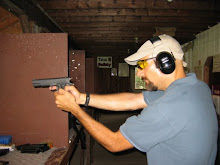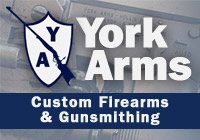Then I was struck with a brilliant idea: Why not detail the steps in a post?
Off to the armory I went, looking for a gun with a spot of surface rust. I knew that the telescoping stock to my Underwood M1 carbine had some surface rust on it from my last gun pron pic, but that's not exactly the same - the folding stock isn't blued, etc. I went through both gun safes looking for a suitable candidate, and was beginning to think I was doing too good of a job storing my guns, as I couldn't find one with enough surface rust to show up in a picture.
And then I spied the lonely JC Higgins 16 gauge in the corner. Oh yes, that will do nicely:

Rust: Our Enemy
Yep. That'll do just fine for the purposes of this post. That's a JC Higgins model 101.7 16 gauge side-by-side shotgun with a nasty case of "safe rash". More than likely, it was put away with a tiny bit of moisture on the barrel, judging from the location, probably where it was carried.
The first step is to gather supplies. I use a two-step approach:
Cleaning, Step One
A little solvent and some 0000 steel wool is all that's needed, really. Apply the solvent (in this case, my trust Hoppes #9) with a Q-tip to the rusted area and coat liberally (about the only place you'll see me advocating doing anything liberally...). Lightly sand with the steel wool, taking care not to put too much pressure on the metal.
If you're especially concerned about the steel wool having an adverse effect on the bluing, try an inconspicuous area first. Under stocks is a great place to test on pistols; for rifles, generally under the forend works fine too. Give a quick test to be sure you won't mar the finish and also to see just how much pressure you should be applying (hint: not much).
Once the rust is gone, it's a good idea to coat the area with some oil:

Cleaning: Step Two
Apply gun oil to the freshly cleaned area, and rub in gently with the steel wool. This helps smooth out any rough spots and gets oil into the surface to inhibit any future rust. If possible, use even lighter of a stroke than for removing the rust - the goal is to work the oil onto the surface, not to remove stubborn rust spots here.
So how does it come out?

Not Too Shabby!
That's a right-nice comparison, if I must say so myself. This whole process took maybe five minutes, start to finish, and you end up with a much nicer finish... It's quick, simple, and produces very satisfying results; really, what more could you ask for? Be sure to store the gun properly to avoid the need for repeat performances, and you're good to go...
And lastly, one obsessive-compulsive gun nut confession: Even though I've never shot this gun, and probably never will, I was unable to put it back in the safe with the other barrel having rust spots. I had to clean the entire outside of the gun before I put it back in the safe...
My name is Jay G., and I'm an obsessive-compulsive gun nut...
That is all.








3 comments:
Not to rain on your parade, BUT might I suggest using bronze wool(available at most boating supply stores) rather than steel wool. The bronze wool will remove the rust without scratching or removing the bluing.
emdfl
I've been using that techneque for over 30 years on dozens of guns. Never fails. Just be careful not to get any solvent on the stock. Not at all good for wood finishes!
Hadn't thought of bronze wool (didn't know it existed). Never had any problems with steel wool.
emdfl,
Very fine bronze wool works really well; it's just that you can find 0000 steel wool at any Home Depot/Lowe's/Wal-Mart around, whereas brass wool is a little harder to find.
I've cleaned dozens of guns in this manner and never had any scratches.
FWIW, this same method will take heavy fouling off of stainless barrels (like Magnum calibers, etc.).
Seth,
Good point. I wasn't concerned on this shotgun because the stock is plastic...
Post a Comment